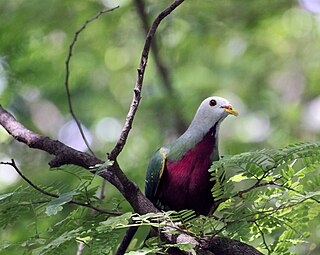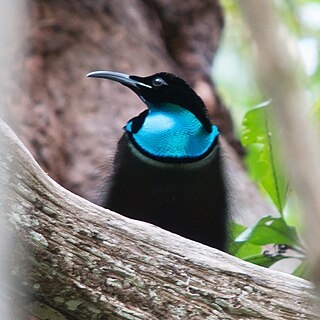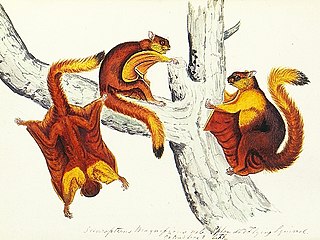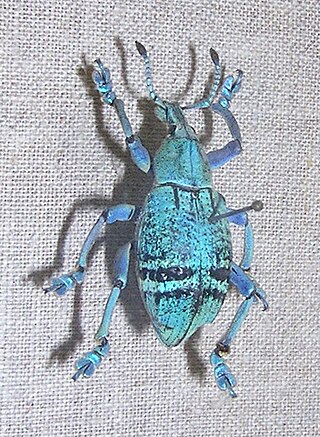
The wompoo fruit dove, also known as wompoo pigeon and "magnificent fruit dove" among others, is one of the larger fruit doves native to New Guinea and eastern Australia.

The magnificent bird-of-paradise is a species of bird-of-paradise. The magnificent bird-of-paradise is evaluated as Least Concern on the IUCN Red List of Threatened Species. They are listed in Appendix II of CITES.

The magnificent riflebird is a species of passerine bird in the birds-of-paradise family Paradisaeidae.

The frilled coquette is a species of hummingbird in the "coquettes", tribe Lesbiini of subfamily Lesbiinae. It is endemic to Brazil.

The white-eared night heron is a species of heron in the family Ardeidae. It is found in southern China and northern Vietnam.. It is threatened by habitat loss and habitat fragmentation.

Hodgson's giant flying squirrel is a species of rodent in the family Sciuridae. This large flying squirrel lives in Himalayan forests in Asia. Like other flying squirrels, it is nocturnal and able to glide long distances between trees by spreading out its patagium, skin between its limbs.

Ancylomenes magnificus, also known as the magnificent anemone shrimp, is a species of cleaner shrimp common to the Western Pacific Ocean at depths of 3–29 metres (10–95 ft). They are commonly found on stony coral, Catalaphyllia and the sea anemone, Dofleinia armata.

Eupholus is a genus of beetle in the family Curculionidae. The genus includes some of the most colourful of the weevils. The colour may serve as a warning to predators that they are distasteful. Most species feed upon yam leaves, some of which are toxic to other animals. The species occur in New Guinea and adjacent islands. This genus was described by French entomologist Jean-Baptiste Alphonse Dechauffour de Boisduval in 1835.

Chiton magnificus, the liquorice sea cradle, is a Southeast Pacific species of edible chiton, a marine polyplacophoran mollusk in the family Chitonidae, the typical chitons.

Eupholus bennetti is a species of beetle belonging to the family Curculionidae.

Eupholus chevrolati is a species of beetle belonging to the family Curculionidae.

Eupholus geoffroyi is a species of beetle belonging to the family Curculionidae.

Eupholus schoenherrii is a species of beetle belonging to the family Curculionidae. Eupholus petitii is sometimes included here as a subspecies.

Eupholus petitii is a disputed species of beetle belonging to the family Curculionidae.

Eupholus tupinierii is a species of beetle belonging to the family Curculionidae.

Eupholus azureus is a species of beetles belonging to the family Curculionidae.

Eupholus humeridens is a species of beetle belonging to the family Curculionidae.

The fruit doves, also known as fruit pigeons, are a genus (Ptilinopus) of birds in the pigeon and dove family (Columbidae). These colourful, frugivorous doves are found in forests and woodlands in Southeast Asia and Oceania. It is a large genus with over 50 species, some threatened or already extinct.

Eupholus nickerli is a species of beetle belonging to the family Curculionidae.



















